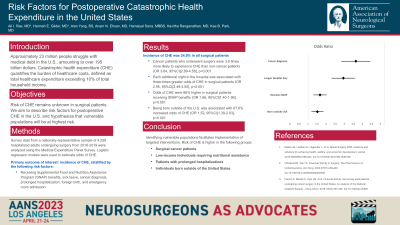Risk Factors for Postoperative Catastrophic Health Expenditure in the United States
Friday, April 21, 2023

- HG
Hannah E. Gilder, MD (she/her/hers)
Resident Physician
Mayo Clinic Rochester
Rochester, Minnesota, United States
ePoster Presenter(s)
Introduction: Approximately 23 million people struggle with medical debt in the U.S, amounting to over $195 billion. Catastrophic health expenditure (CHE) quantifies the burden of healthcare costs, defined as total healthcare expenditure exceeding 10% of total monthly household income. Risk of CHE remains unknown in surgical patients. We aim to describe risk factors for postoperative CHE in the U.S. and hypothesize that vulnerable populations will be at highest risk.
Methods: Survey data from a nationally-representative sample of 4,258 hospitalized adults undergoing surgery from 2016-2019 were analyzed using the Medical Expenditure Panel Survey. The primary outcome of interest was incidence of CHE stratified by various risk factors, including receiving Supplemental Food and Nutrition Assistance Program (SNAP) benefits, sick leave, cancer diagnosis, prolonged hospitalization, foreign birth, and emergency room admission. Logistic regression models were used to estimate odds of CHE.
Results: Incidence of CHE was 24.9% in all surgical patients. Cancer patients who underwent surgery were 3.6 times more likely to experience CHE than non-cancer patients (OR 3.64, 95%CI[2.89–4.58],p < 0.001). Each additional night in the hospital was associated with approximately 3 times greater odds of CHE in surgical patients (OR 2.95, 95%CI[2.49–3.498],p < 0.001]. Odds of CHE were 66% higher in surgical patients receiving SNAP benefits (OR 1.66, 95%CI[1.40–1.96],p < 0.001) compared to those without benefits. Being born outside of the U.S. was associated with 68% increased odds of CHE (OR 1.68, 95%CI[1.39–2.03],p < 0.001). There was no difference in CHE incidence for those admitted from the ER versus the electively admitted(p=0.469).
Conclusion : Risk of CHE is higher in surgical cancer patients, low-income individuals, those with prolonged hospitalizations, and those without protective labor benefits. Identifying vulnerable populations facilitates implementation of targeted interventions.
Methods: Survey data from a nationally-representative sample of 4,258 hospitalized adults undergoing surgery from 2016-2019 were analyzed using the Medical Expenditure Panel Survey. The primary outcome of interest was incidence of CHE stratified by various risk factors, including receiving Supplemental Food and Nutrition Assistance Program (SNAP) benefits, sick leave, cancer diagnosis, prolonged hospitalization, foreign birth, and emergency room admission. Logistic regression models were used to estimate odds of CHE.
Results: Incidence of CHE was 24.9% in all surgical patients. Cancer patients who underwent surgery were 3.6 times more likely to experience CHE than non-cancer patients (OR 3.64, 95%CI[2.89–4.58],p < 0.001). Each additional night in the hospital was associated with approximately 3 times greater odds of CHE in surgical patients (OR 2.95, 95%CI[2.49–3.498],p < 0.001]. Odds of CHE were 66% higher in surgical patients receiving SNAP benefits (OR 1.66, 95%CI[1.40–1.96],p < 0.001) compared to those without benefits. Being born outside of the U.S. was associated with 68% increased odds of CHE (OR 1.68, 95%CI[1.39–2.03],p < 0.001). There was no difference in CHE incidence for those admitted from the ER versus the electively admitted(p=0.469).
Conclusion : Risk of CHE is higher in surgical cancer patients, low-income individuals, those with prolonged hospitalizations, and those without protective labor benefits. Identifying vulnerable populations facilitates implementation of targeted interventions.
